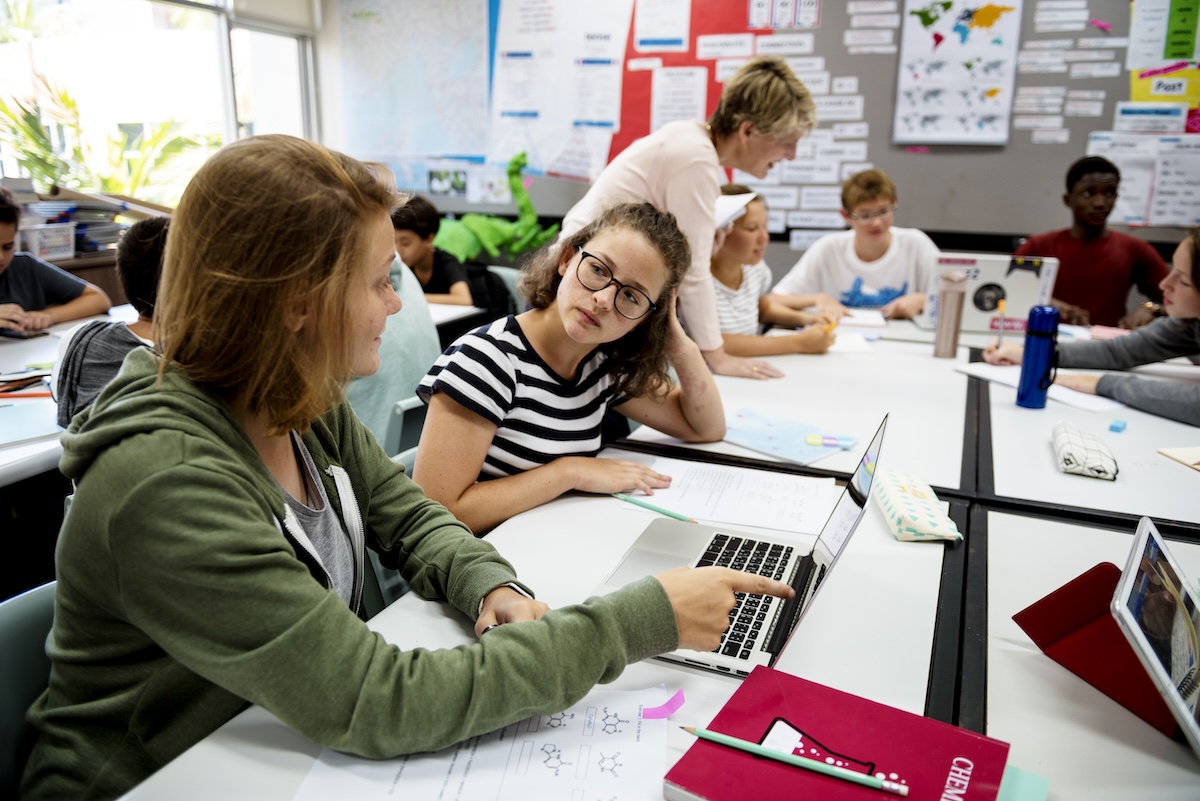As educators, we know that preparing young people for future study and the workplace is a core part of our job. One highly effective tool for developing essential 21st-century skills—such as communication, collaboration, and the ability to reach shared goals—is cooperative learning.
However, working out how to successfully implement this approach in your practice can be tough. Cooperative learning tasks can require careful planning, focused behavior management, and a heavy research burden.
To help you get the most out of this technique, we’ve put together a guide explaining how it works, its benefits, and some cooperative learning strategies you can try out in your classroom today.
Key Takeaways
- Cooperative learning means students working together for a shared goal.
- This is a great way to help students develop key skills for the future, including communication and collaboration.
- Opportunities can be extended and more formal, or shorter and more informal.
- Set clear behavior guidelines before you begin and consider whether you need to give more or less structure to the groups depending on their levels of independence.
What Is Cooperative Learning?
Cooperative learning is more than simply discussion or peer marking. It encourages students to work together to achieve collective goals and entails significant communication, mutual understanding, and taking responsibility for their role in the group. It can be contrasted with learning that is purely individualistic (focused on each student completing their own tasks) or competitive (where students attempt to “win” by beating others).
Why Is Cooperative Learning Important?
Cooperative learning is essential preparation for students’ future pathways, whether that’s college study or the workplace. Integrating cooperative learning into your classroom can help your students develop the key skills they’ll need for teamwork, including clear communication and helpfulness. It also improves their ability to solve conflicts, negotiate, and take on leadership roles.
What’s more, cooperative learning directly addresses 21st-century skills such as problem-solving, creativity, and critical thinking, which will be essential for tackling tomorrow’s obstacles. Working in a group can help students deal with and synthesize diverse viewpoints, as well as being able to generate new ways of looking at things and bring others along with them.
Multiple studies also demonstrate that cooperative learning can improve students’ test scores. Students memorize information better and develop a deeper understanding of topics when they’re required to explain their ideas to the rest of the group and respond helpfully to what others have to say.
Students may also need to approach lesson material in a variety of ways, including writing, speaking, and even creative interpretations, which cements it more effectively than passive reception. The creativity and variety of cooperative tasks can also increase motivation to learn.
Types of Cooperative Learning
We can divide cooperative learning into 2 main types:
Formal cooperative learning
Formal cooperative learning opportunities are highly structured and rigorously planned, taking into account the level of independence your students are ready for and scaffolding accordingly. You can also structure the activities to help them build towards more self-guided group tasks.
These activities can be lengthy, perhaps taking a whole lesson or, more often, a suite of lessons. There should be clear assessment criteria for students to work towards, but it’s also important to run through which social skills you’ll be working on.
Examples include:
- Students work together on a group investigation over a number of lessons.
- Teams prepare the different sides of a debate to take place in a future lesson.
- Pairs or small groups take the term to prepare a website, newspaper, or video documentary about a particular topic.
You should monitor students closely during the unit of study and build in opportunities for formative assessment. You may also be able to conduct a summative assessment at the end of the unit.
Informal cooperative learning
Informal cooperative learning is usually shorter in duration, perhaps only 1 lesson or 1 activity. Students should still have a structured task and goal, but it may require less in-depth setup and explanation. There will be opportunities for formative assessment, but this may be less suitable for final, summative assessment.
For example:
- Think-pair-share: Students come up with their own response to a thought-provoking question, share with a partner, and then discuss with the wider group.
- 30-second summary: Students take 30 seconds each to summarize previous learning, and then answer a more complex question together.
- Create a poster: Students must work together to capture the previous lesson’s topic in a visual format.
Cooperative vs. Collaborative Learning: Key Differences
You may have also heard the term collaborative learning. Collaborative learning tasks see learners go off and do their own self-directed study, coming back to share with others in debate, discussion, or online comments. This differs from cooperative learning, where students work together on a structured task that has shared outcomes.
6 Strategies for Implementing Cooperative Learning in the Classroom
When bringing cooperative learning into your classroom, consider the following strategies for success:
1. Set the ground rules
In cooperative learning, it’s really important to set clear rules and boundaries. One way to give students more ownership here is to ask them to generate and agree on some of the rules themselves. Students will probably have a good idea of what works well when they need to cooperate—such as not speaking over each other, respecting each other’s ideas, and keeping on task.
2. Use team-building exercises
Once you’ve assembled your students into their cooperative groups, it can be a good idea to help them bond by introducing some ice-breaker activities. This is especially important if you plan for the cooperative learning activities to stretch over several lessons. A great example is the game “2 Truths and a Lie,” where students guess which facts about their teammates are untrue.
3. Try the “jigsaw” method
Divide students into small groups and assign each a different research topic. For example, my history students worked together to prepare a guide on the British Empire’s impact in a particular country.
Once each group has completed their guide, split the students into new groups with 1 member from each of the previous teams. Students then share their knowledge so the new teams have now learned about every topic—piecing together the bigger picture of the “jigsaw.”
New teams can then work together to answer an evaluative question (from my example, something like “Why is the British Empire an important topic to learn about in today’s world?”).
4. Assign group investigations
A more advanced technique is asking students to design and complete a group investigation. For example, in science, this could be asking them to design a new type of flying machine or come up with a way to test a certain chemical reaction.
This activity mimics the tasks students may need to do in their future lives. Together, they must decide the parameters of their investigation, assign tasks in the group, and complete a draft before presenting it to the rest of the class.
5. Use technology
Technology can be a great way to facilitate cooperation, whether that’s inside or outside the classroom. This can be as simple as asking students to work on a joint document, or as complex as using a digital testing platform like TAO to set up a virtual experiment lab, where students can work together like real-life scientists without the need for complex equipment.
6. Consider base groups
While ad-hoc or short-term group work can be effective, you may also decide to organize students into base groups. These are long-term groups or teams that remain stable across a semester or even a whole school year. They might work on different tasks or projects, or perhaps on an overarching project that can run alongside your other work, such as looking at how they can apply new learning techniques across classes.
Further Resources for Teachers
- More on the importance of cooperative learning from the University of Cincinnati
- A list of cooperative learning approaches from San Diego University
- A look at how to arrange your classroom for cooperative learning from the Chartered College of Teaching
A cooperative learning approach has several benefits, including preparing students for their futures and potentially boosting their grades. Implementing it in the classroom can take some planning and preparation, but with our simple strategies, you can get started in no time.
As a next step, consider how cooperative learning could be a great opportunity to assess social-emotional skills. You may also want to explore classroom management techniques so you can deliver cooperative learning with confidence.
Get Started With Digital Assessment With TAO
Cooperative learning is a powerful way to promote students’ communication skills and responsibility within a group. You can also deliver this online, using TAO’s customizable digital assessment platform that gives you the power to build a variety of question types that simulate real-world problem-solving situations.
Want to find out more? Schedule a demo to learn how to bring digital assessment to your classroom.
FAQs
How do students benefit from cooperative learning?
Cooperative learning helps students develop skills of communication, personal responsibility, and working with others. These social-emotional skills are vital elements of many jobs and important life scenarios, and therefore equip students for their futures.
What problems might arise during cooperative learning?
Student conflict can sometimes arise during cooperative learning. Some students may also go off task if they feel the work is being handled by other group members. It’s therefore important to set and agree on clear behavior guidelines from the start.

